Siem Reap Cambodia Day 3 Part Two: Sras Srang, Ta Prohm / Tomb Raider Temple, Ta Keo, Banteay Kdei, Prasat Kravan, Phnom Bakheng
Siem Reap Cambodia Day 3 Part Two: Sras Srang, Ta Prohm / Tomb Raider Temple, Ta Keo, Banteay Kdei, Prasat Kravan, Phnom Bakheng
Sras Srang
Please don’t mistaken Sras Srang as another temple in Angkor.
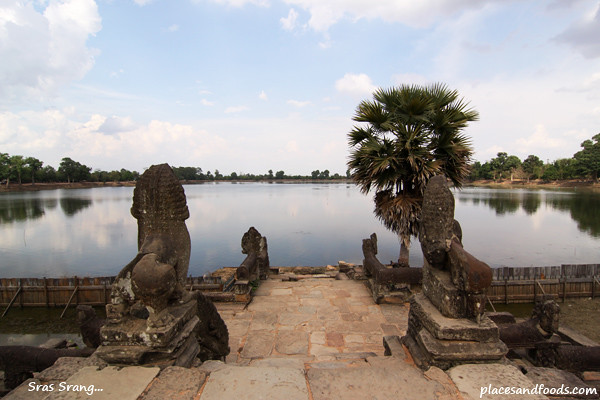
Sras Srang is an ancient manmade lake which is 800m by 400m. It was built by King Rajendravarman II in mid 10th century. Later, this lake was restored and enlarged by King Jayavarman VII in late 12th century.
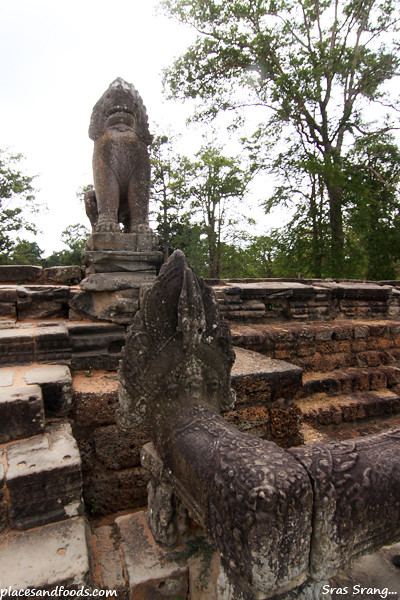
Originally, there was a small shrine in the middle, but today it completely collapsed that we could only see its stone foundation in the dry season. Besides storing water for agriculture, Sras Srong was also used daily by students and monks who stayed in Banteay Kdei temple which was a Buddhism Education Center in late 12th century. There is a royal sandstone platform which is decorated with Naga balustrades and two lion statues as guardians to the west side. This platform was used by the royalty and dignitary families to see the ceremony while the public sat on the steps or grandstand surrounding this lake to watch the festival. – http://www.cambodiatourservices.com
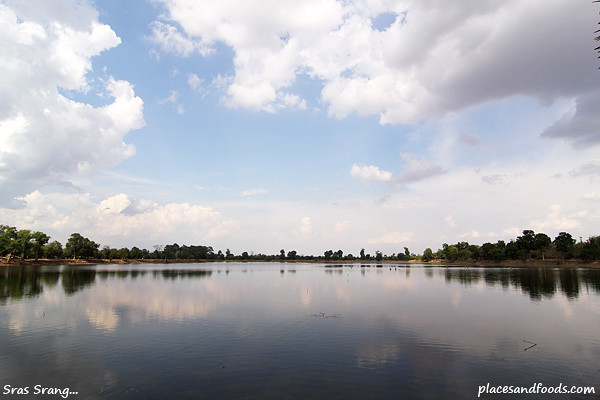
Sras Srang can is located at the front of the Angkor Wat. Due to its size, it can be spotted easily. Some of the locals believed this was the swimming pool of the late King. If it is true, it was a massive swimming pool indeed!
Ta Prohm / Tomb Raider Temple
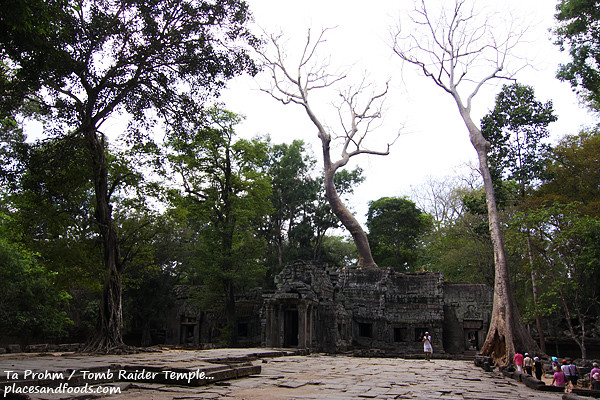
Remember the movie Tomb Raider acted by Angelina Jolie? If you don’t remember, visiting Ta Prohm will give you a dejavu. Ta Prohm was popularized by the famed of the movie and the temple is as popular as Angkor Wat.

Ta Prohm (Khmer: ប្រាសាទតាព្រហ្ម) is the modern name of a temple at Angkor, Siem Reap Province, Cambodia, built in the Bayon style largely in the late 12th and early 13th centuries and originally called Rajavihara (in Khmer: រាជវិហារ). Located approximately one kilometre east of Angkor Thom and on the southern edge of the East Baray, it was founded by the Khmer King Jayavarman VII as a Mahayana Buddhist monastery and university. Unlike most Angkorian temples, Ta Prohm has been left in much the same condition in which it was found: the photogenic and atmospheric combination of trees growing out of the ruins and the jungle surroundings have made it one of Angkor’s most popular temples with visitors.
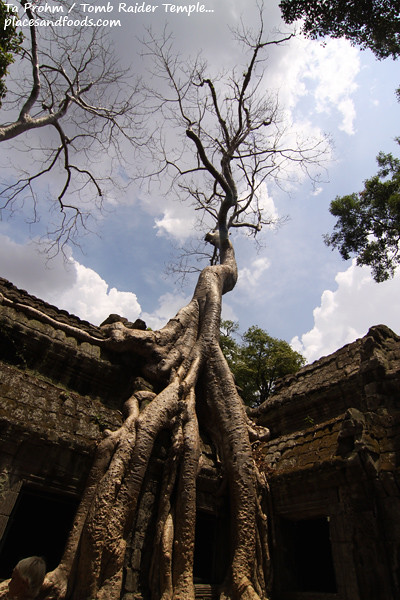
The signature of this temple will be the iconic huge tree grown in the temple.
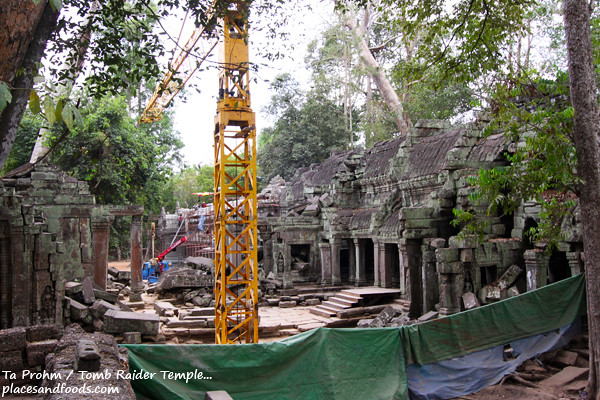
Huge restoration works can be seen on this temple and it is one of the busiest temples we visited in Angkor.
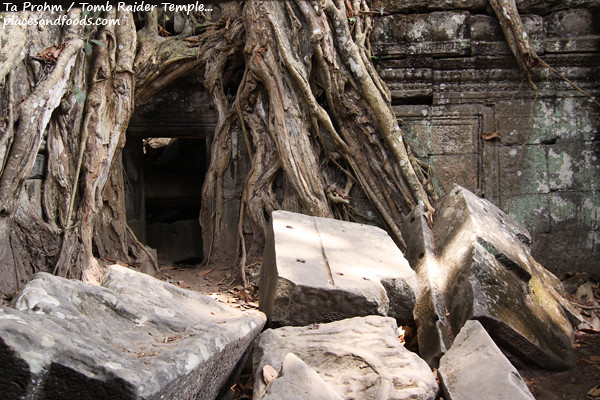
We recommend visitors to visit this temple after lunch as most tour companies will visit this temple in the morning. Hence, we avoided a larger crowd and managed to capture more pictures of the temple. This was the sixth temple we visited of the day.
Ta Keo
Moving on and equipped with lots of H20 (water) we visited Ta Keo next.
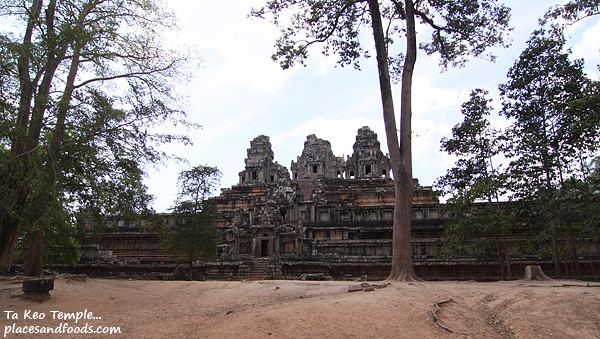
Ta Keo (Khmer: ប្រាសាទតាកែវ) is a temple-mountain, in Angkor (Cambodia), possibly the first to be built entirely of sandstone by Khmers.
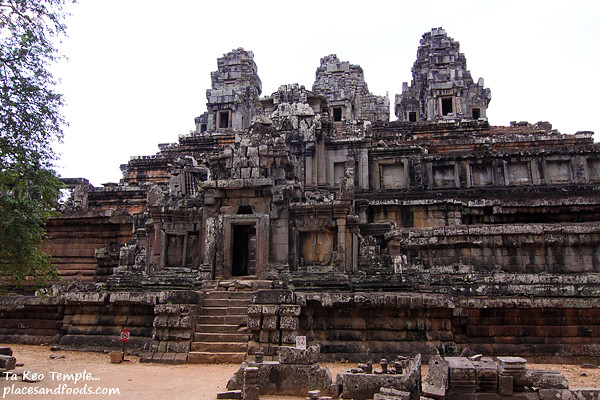
Ta Keo had to be the state temple of Jayavarman V, son of Rajendravarman, who had built Pre Rup. Like Pre Rup, it has five sanctuary towers arranged in a quincunx, built on the uppermost level of five-tier pyramid consisting of overlapping terraces (a step pyramid), surrounded by moat, as a symbolic depiction of Mount Meru. Its particularly massive appearance is due to the absence of external decorations, as carving had just begun when the works stopped, besides an elaborate use of perspective effects. It is considered an example of the so-called Khleang style.
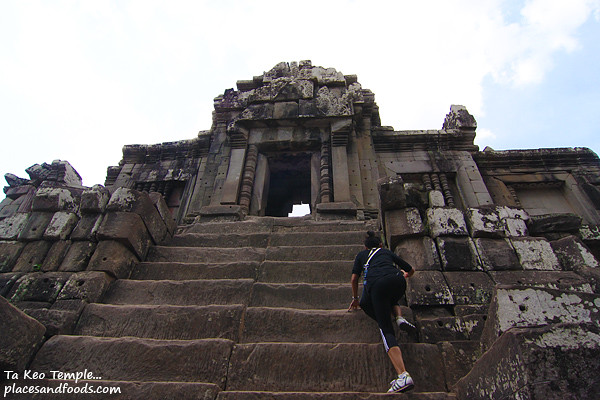
Ta Keo had the steepest stairs ever. We remembered clearly climbing up the five levels were not an easy task. Our tour guide decided to stay in the air conditioned van and watching us climbing the stairs.
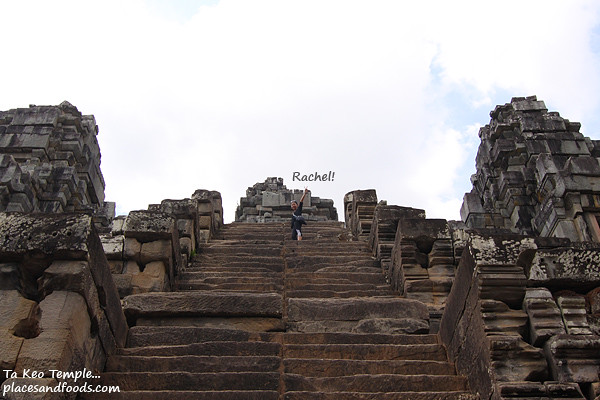
Rachel went up early while I took my time climbing the stairs. At the top of the temple, we met a Taiwanese girl who was backing alone in Southeast Asia.
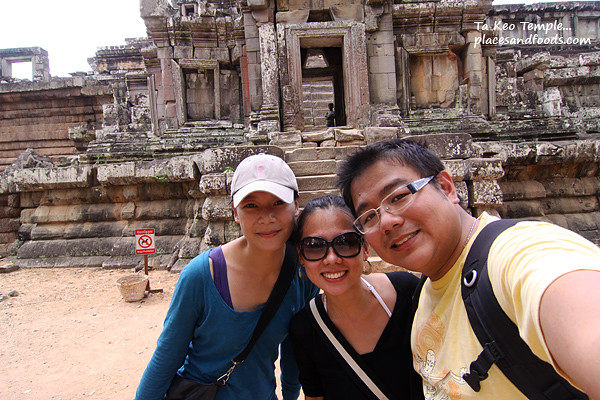
We took a picture together as we met another friendly traveler.
We rested at the top of the temple for almost half an hour.
Banteay Kdei
We couldn’t believe that Banteay Kdei was the eight temple of the day. We thought we might quit on the fourth or fifth temple visit but we made it to the eight so far. After liters of bottled water, we still have the energy to visit Banteay Kdei.
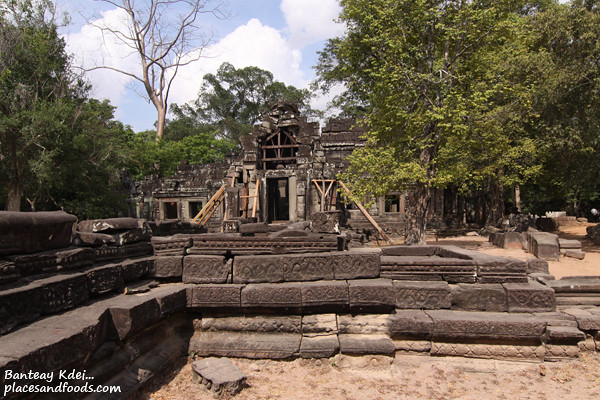
Banteay Kdei (Khmer: ប្រាសាទបន្ទាយក្តី, Prasat Banteay Kdei), meaning “A Citadel of Chambers”,also known as “Citadel of Monks’ cells”, is a Buddhist temple in Angkor, Cambodia. It is located southeast of Ta Prohm and east of Angkor Thom. Built in the mid 12th to early 13th centuries AD during the reign of Jayavarman VII (who was posthumously given the title “Maha paramasangata pada” it is in the Bayon architectural style, similar in plan to Ta Prohm and Preah Khan, but less complex and smaller. Its structures are contained within two successive enclosure walls, and consist of two concentric galleries from which emerge towers, preceded to the east by a cloister.
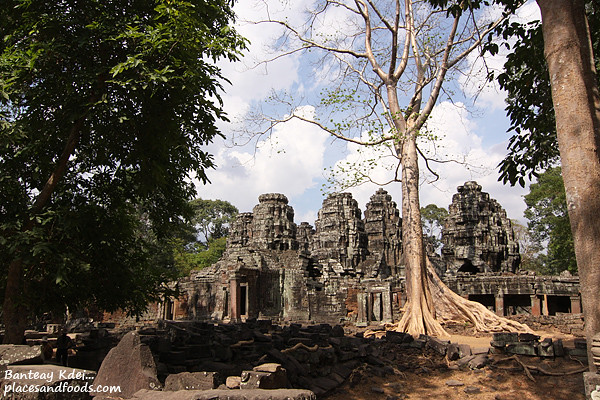
This Buddhist monastic complex is currently dilapidated due to faulty construction and poor quality of sandstone used in its buildings, and is now undergoing renovation. Banteay Kdei had been occupied by monks at various intervals over the centuries till 1960s.
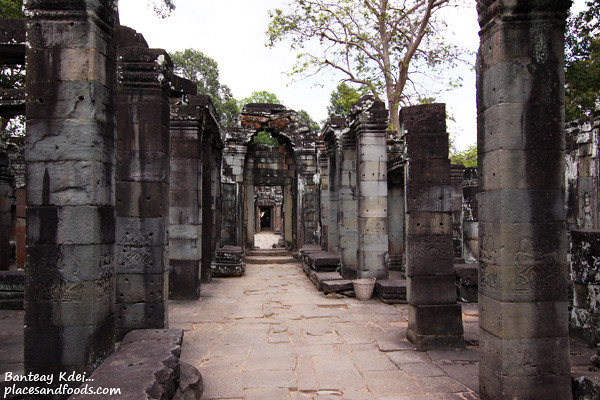
We remembered clearly there is one corridor in the temple has the length of many doors. We can see the almost the far end at the entrance of the corridor.
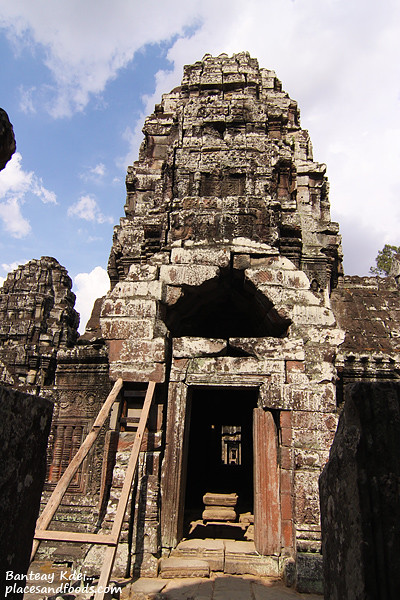
Even though the temple is single level but it is larger than we thought.
Prasat Kravan
Prasat Kravan was another temple that we felt has the similarities with Roluos Group of Temples: Bakong, Preah Ko and Lo Lei Temple.

Prasat Kravan (Khmer: ប្រាសាទក្រវ៉ាន់) is a small 10th century temple consisting of five reddish brick towers on a common terrace, located at Angkor, Cambodia south of the artificial lake or baray called Srah Srang. Its original Sanskrit name is unknown. The modern name in Khmer, “Prasat Kravan”, means cardamom temple. The temple was dedicated to Vishnu in 921 CE, according to inscription on door jambs.
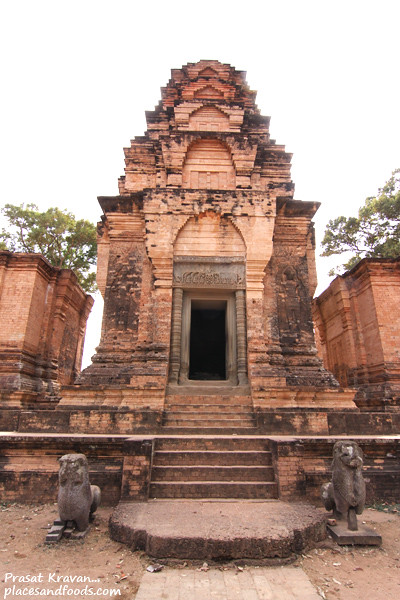
The site was cleaned from vegetation in the Thirties by Henri Marchal and Georges Trouvè. Afterwards the towers were restored on Bernard Philippe Groslier’s initiative from 1962 to 1966, adding some new bricks which are marked with a “CA” (meaning “Conservation Angkor”).[3]
The temple is oriented to the East and surrounded by a small moat. Its exterior is striking for its classical lines and symmetry, the central and the south tower have superstructures which take advantage of false prospective by simple means of diminishing tiers. The sanctuaries interiors are remarkable for the large bas relief depictions of Vishnu and Lakshmi that have been carved into the walls of reddish brick, connected by a vegetable compound.

In our opinion, Prasat Kravan is the most restored temple we have seen in Angkor. It was not vandalized as most of the temples in Angkor and the temple look neat and clean. This was our ninth temple visit and we still have energy in us to complete our tenth temple visit at Bakheng Hill.
Phnom Bakheng
Phnom Bakheng was our tenth temple and the last temple visit of the day. The temple is located at the top of the Bakheng Hill and it didn’t make it easier for us after visiting nine temples in a day.
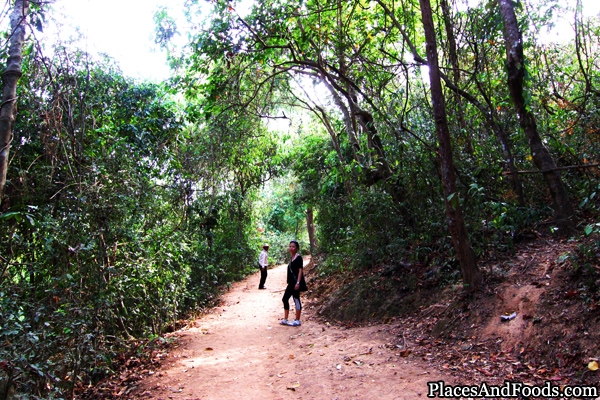
Phnom Bakheng (Khmer: ប្រាសាទភ្នំបាខែង) at Angkor, Cambodia, is a Hindu temple in the form of a temple mountain. Dedicated to Shiva, it was built at the end of the 9th century, during the reign of King Yasovarman (889-910). Located atop a hill, it is nowadays a popular tourist spot for sunset views of the much bigger temple Angkor Wat, which lies amid the jungle about 1.5 km to the southeast. The large number of visitors makes Phnom Bakheng one of the most threatened monuments of Angkor.
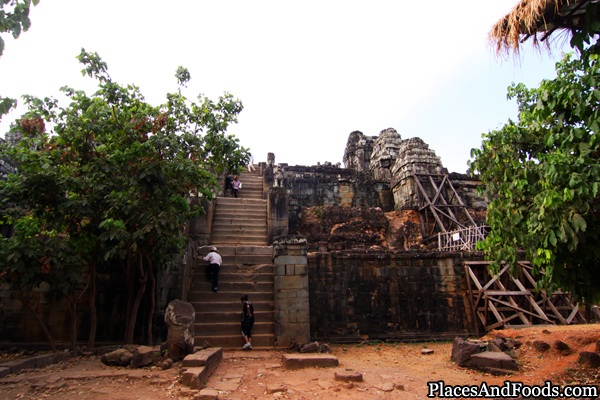
The view of the Angkor Wat from the top of Phnom Bakheng is featured in the movie Tomb Raider (when Lara Croft looks through the binoculars upon arriving in Cambodia).
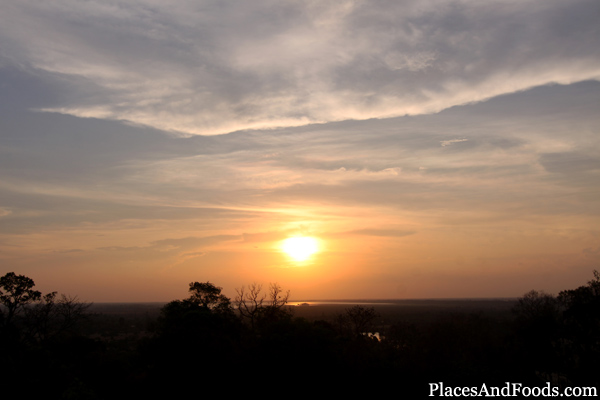
If you enjoy the beauty of the sunrise at Angkor Wat then you should enjoy the sunset view at Bakheng Hill. Both of them are equally good.
That’s why there are dozens of tourists swarmed the temple with tripods, cameras and even video cameras for the sunset. You can read our full review on it at Sunset Fun at Bakheng Hill.
We hope you enjoy reading our temples adventure on Siem Reap Cambodia Day Three as we have put a lot of efforts by researching and making sure we have the right facts on the temples we visited. We took most of our research and facts and even some of the context from Wikipedia.org.
We have an early flight on Day four so there is no point blogging about it. Hence, we hoped that with all the information we included in this 3 days, you can plan out your own itinerary for your trip to Siem Reap. Please bear in mind that we didn’t visit all the temples in Siem Reap and there are more out there. We hope you enjoy our three days of crazy adventure in Siem Reap. Thank you for reading.
Please check out our other Siem Reap adventure:
Siem Reap Cambodia Day 1: AirAsiaGo.com Package, Tonle Mekong Restaurant, Angkor Spirit Palace Hotel, Lake Tonle Sap, Killing Field, Pub Street and Le Tigre de Fapier
Siem Reap Cambodia Day 2: Angkor Wat, Bayon, Banteay Srei, Roluos Group Temples, Bakong, Preah Ko and Lo Lei
Siem Reap Cambodia Day 3 Part One: Preah Khan, Neak Pean, Ta Som, Eastern Mebon, Pre Rup
Siem Reap Cambodia Day 3 Part Two: Sras Srang, Ta Prohm / Tomb Raider Temple, Ta Keo, Banteay Kdei, Prasat Kravan, Phnom Bakheng




